Last updated on October 29, 2023
Spaghetti Aglio, Olio e Peperoncino 🍝 Traditional Italian recipe
Garlic, olive oil, red chili pepper, chopped parsley and spaghetti al dente. We are Italians and we prepare the recipe step by step
Last updated on October 29, 2023
Garlic, olive oil, red chili pepper, chopped parsley and spaghetti al dente. We are Italians and we prepare the recipe step by step
Spaghetti aglio olio e peperoncino is a typical dish of the Neapolitan cuisine, and one of the most iconic Italian pasta sauces.
The ingredients are all traditional products of Mediterranean cuisine, and specifically of Campania, the southern Italian region where Naples is located:
Garlic, in the Allium neapolitanum variety (Neapolitan garlic), cultivated throughout the Mediterranean;
Extra Virgin olive oil, of which the Campania region is one of the major producers in Italy;
Red chili pepper, which in the city of Naples has always had a superstitious value: chilli pepper brings good luck. The Municipality of Naples even organizes a festival on the theme of Food e Scaramanzia (Food and Superstitiousness).
Dry pasta made of durum wheat semolina, in the tradition of southern Italy.
On this page of All Italian we share all the tricks to prepare a proper plate of Spaghetti aglio olio e peperoncino, «al dente» like we like it in Italy.
The Italian words we use on this page:
| 🔊 Spaghetti | Spaghetti |
| 🔊 Aglio | Garlic |
| 🔊 Olio d'oliva | Olive oil |
| 🔊 Peperoncino | Red pepper |
| 🔊 Spaghettata | Spaghetti meal (usually with friends) |
The pasta aglio olio e peperoncino recipe is very easy to make. For an excellent pasta sauce, just follow our tips: we make the recipe with you, step by step.
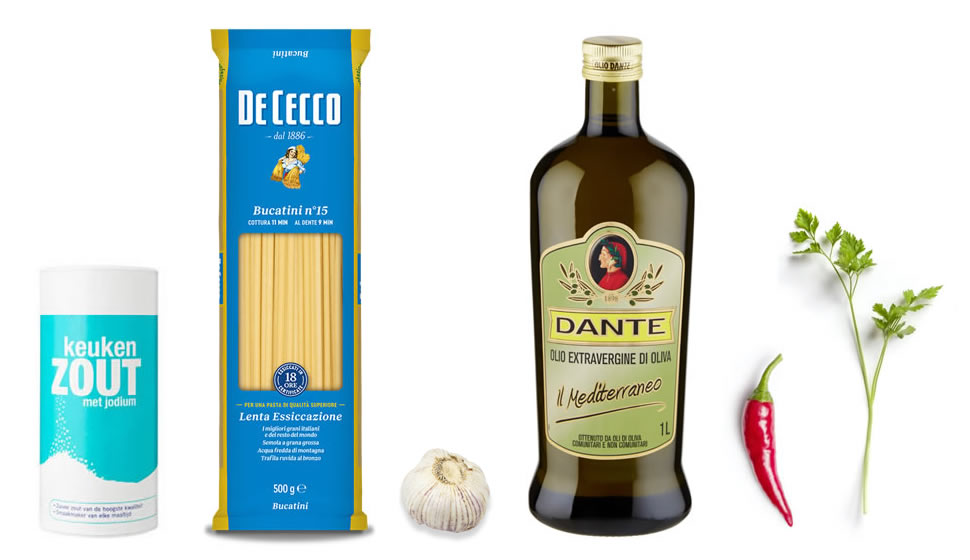
| Ingredient image | Ingredient name | Cups | Grams | Ounces |

|
Spaghetti | 11.29 oz | 320 g | |

|
Garlic | 3 cloves | ||
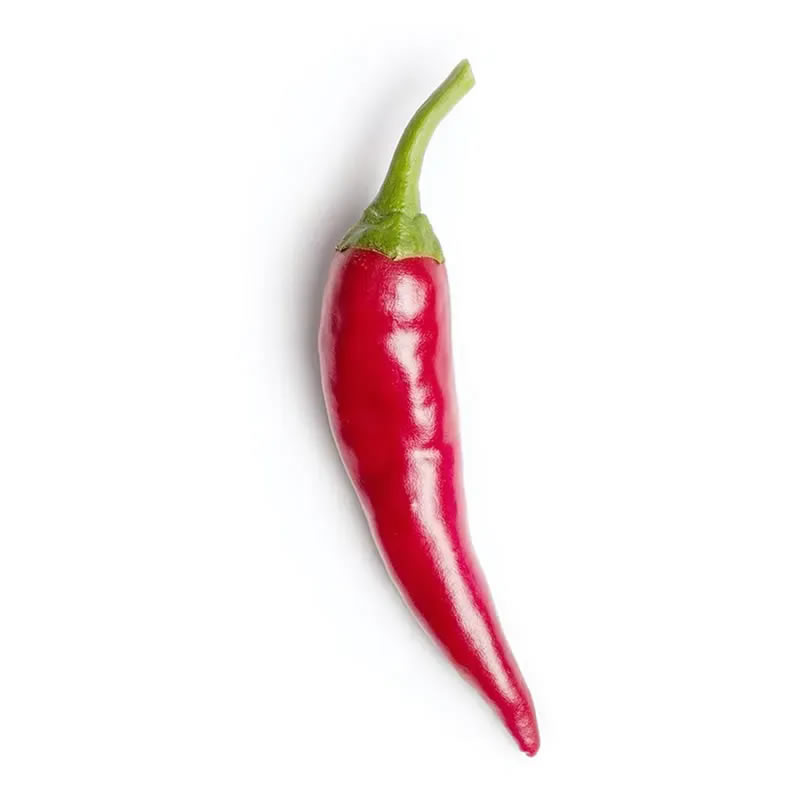
|
Chilli pepper | 2 peppers | ||

|
Parsley | 1 sprigs | ||

|
Extra Virgin Olive Oil | 6 tablespoons |
The ingredients of pasta aglio olio e peperoncino are all typical products from Naples and the Campania region.
Thick spaghetti, for example number 12, is delicious with aglio olio e peperoncino.
The pasta we mostly eat in Italy is the dry one, from the supermarket. There's nothing wrong with that. However we recommend spaghetti made entirely of durum wheat semolina: it will be of higher quality. Until recently, pasta made also of soft wheat flour could not be sold in Italy because Italians consider it to be of inferior quality.
Good quality spaghetti absorbs the sauce better and makes the pasta tastier.
Olive oil is one of the three main ingredients in this recipe: we don't have a specific brand to recommend, but we recommend using good quality extra virgin olive oil.
Garlic is widely used in Neapolitan cuisine and in southern Italy in general. The white garlic plant is called Allium Neapolitanum and grows throughout the Mediterranean. The flowers and the bulb are used to flavor many recipes.
Both fresh garlic and seasoned garlic are good for pasta aglio olio e peperoncino. If you find it, use fresh garlic, perhaps in the purple garlic variety: it is better suitable to be sautéed in olive oil.
👉 Garlic should not be cut into small pieces. Traditionally, garlic is merely peeled before being added to the still cold oil; but it should not be chopped.
Cooking garlic is also the only step in the recipe that you pay attention to: garlic burns easily in boiling oil and it is easy to spoil the taste of the dish. Below we explain how you can avoid the most common mistakes when preparing pasta aglio olio.
Just like garlic, you can use both dried and fresh chili - although fresh chili tastes better in our opinion.
Before adding the fresh chili, you can remove the seeds.
Parsley is used in Neapolitan as well as in Roman cuisine: for example, it is also used in pasta all' Arrabbiata. It has a less strong taste than basil, but it significantly changes the flavor of the sauce.
Like basil, parsley should be added fresh at the end of cooking, before serving. It's fine to add it cut into small leaves or even chopped.
First fill a large pot with cold water for the pasta and warm it up over medium heat.
The rule is to use 1 US quart / 1 liter of water for each 3.5 oz / 100 grams of pasta. In this way we cook the pasta without wasting water.
Cover the pot to make the water boil faster.
Meanwhile, remove the skin from the garlic cloves, cut the chili pepper into small pieces.
Also chop the parsley, which we add at the end of the recipe.
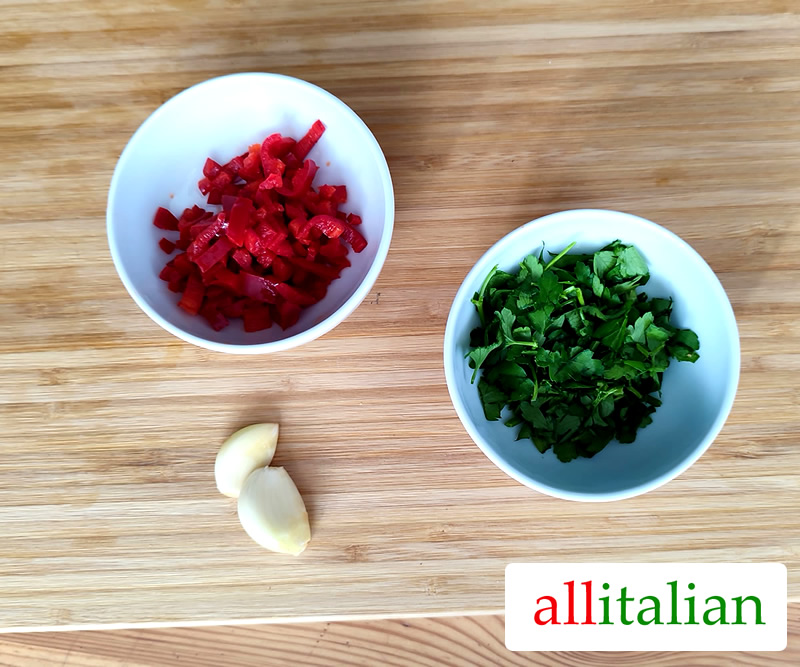
When the water boils, add the coarse salt. Then throw the spaghetti (in Italian we say 🔊 butta la pasta, throw the pasta).
👉 Also for coarse salt there is a rule: 0.35 oz / 10 g of coarse salt for each 1 US quart / liter of cooking water.
While the spaghetti is cooking, we will make the pasta sauce.
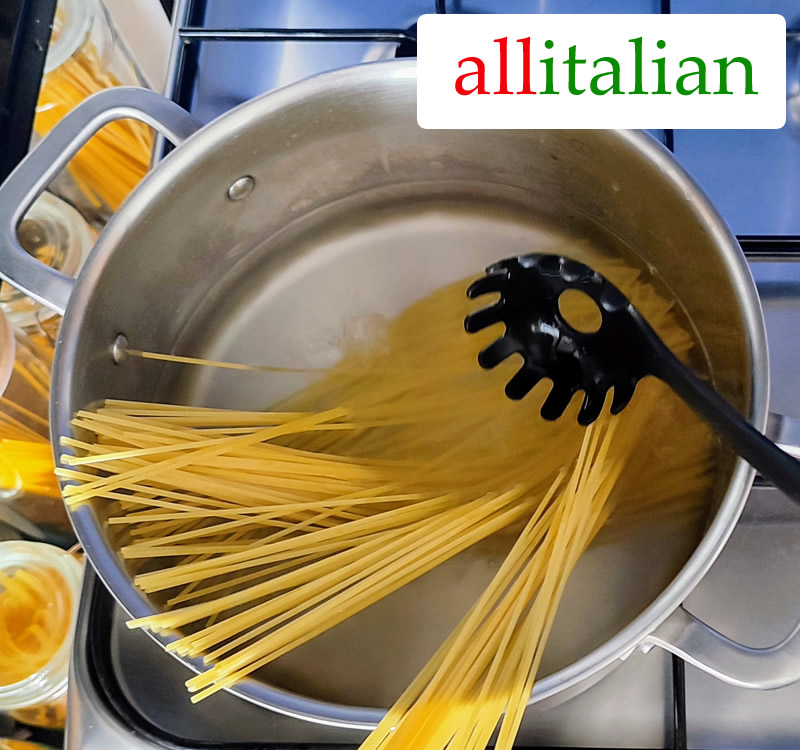
We didn't start earlier with the sautéed sauce to prevent it from becoming too dry, while we wait for the pasta to cook.
Pour the olive oil into a pan and add the garlic clove to the still cold oil. Keep the heat low. As we wrote, this is an important step: the garlic should not brown; you just need to season the olive oil with the taste of garlic.
Add the chili pepper, cut into pieces and possibly without seeds.
In the meantime, check the cooking status of the pasta. In Italy we do not trust much of the cooking time indicated on the packaging.
Is the pasta almost done but not yet al dente?
It's time to transfer spaghetti from the pasta water to the pan with the olive oil.
For this you can use a colander or even better a spaghetti spoon.
👉 Don't forget to remove the garlic from the sauce before adding the pasta.
Stir the pasta in the pan with olive oil for a little while.
To get a creamy paste, add half a ladle of starch-rich pasta water while continuing to mix.
After two minutes, the spaghetti aglio olio e peperoncino is ready!
Add the chopped parsley and serve immediately: pasta aglio olio is delicious when it is still hot.
As we say in Italy: 🔊 buona spaghettata!.

Your spaghetti aglio, olio e peperoncino is ready. Buon appetito! 🍝
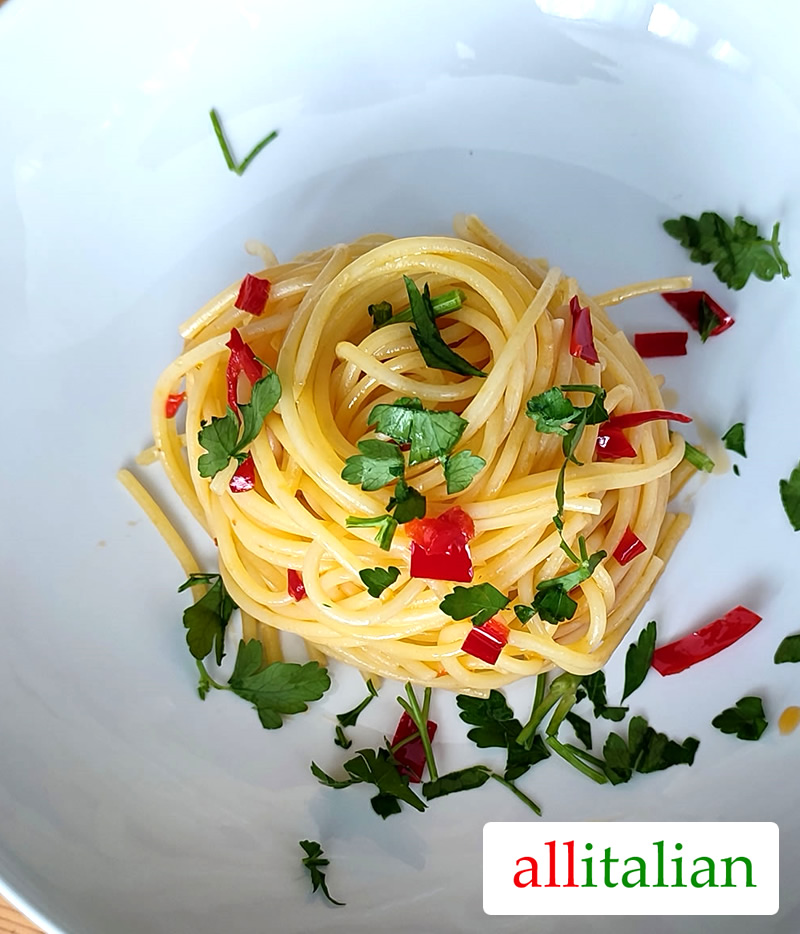
In the restaurant in Italy, when you finish eating, the waiter will ask: 🔊 andava tutto bene? (was everything fine?)
Light cooking the garlic in olive oil is the first step of the recipe, and it is also the step that requires more caution.
If garlic is immersed in boiling oil, it burns easily. And the burnt garlic spoils the taste of spaghetti.
To make the perfect 🔊 soffritto, we recommend keeping the fire very low and heating the oil very slowly. The aim is only to flavor the oil with the taste of garlic: the garlic must not change color, it must not brown or burn.
For this reason too, it is important not to chop it: the garlic clove should be added whole when the oil is still cold, so that it can be removed easily.
Some also suggest adding a little cooking water to the oil at this step of the recipe, to prevent it from reaching too high a temperature and burning the garlic.
Making a perfect aglio olio e peperoncino sauce, but then overcooking the pasta is not ideal. In Italian, overcooked pasta is called 🔊 pasta scotta.
👉 See also: how to cook pasta al dente.
We\'ve written a how-to with all the details to avoid this and cook pasta al dente.
When cooking spaghetti aglio olio, we always recommend removing them from the pasta water 2 minutes before they are al dente: if they are not fully cooked yet drain them from the pasta water and place them in the saucepan. Stir for a few minutes over a low heat: this will make the pasta very tasty and never al dente.
How much oil does go into pasta aglio olio e peperoncino? If you try to make the recipe you will notice that you need more oil than usual to obtain enough sauce to dress all the spaghetti in the pan.
To make enough sauce, some recipes suggest using a glass of oil: we added 80 ml for 4 people, which is already plenty.
👉 To get a creamy pasta sauce there is a different trick, which does not involve adding more oil.
As we explain in the recipe, towards the end of cooking you can toss the spaghetti in the pan with olive oil by adding half a ladle of pasta water and let it mix for another two minutes.
In Italy we usually associate the aglio olio e peperoncino sauce with long pasta, which is historically produced in Naples.
The classic combination of pasta and sauce is Spaghetti aglio olio e peperoncino, but in Campania they traditionally enjoy it with other types of long pasta such as vermicelli and linguine. In Naples this dish is also known as vermicelli alla borbonica or vermicelli con le vongole fujute (vermicelli with escaped clams).
If spaghetti or other long pasta is not available, then in Italy we also eat short pasta with aglio olio sauce: for example Penne Rigate, provided it is al dente, i.e. not overcooked.
The original recipe contains only the ingredients listed in the name. If you add vegetables or tomato sauce, pasta aglio olio is of course no longer called that. However, there are some additional ingredients that you can add to taste and are considered part of the traditional recipe.
If you like the taste, you can add them together with the chilli and let them brown in the oil.
To make the recipe richer you can add some cherry tomatoes, halved. No tomato sauce, otherwise you get a Arrabbiata pasta sauce from the Roman tradition.
An alternative version of the garlic oil paste does not contain chili, but replaces it with black pepper.
A custom we have in Italy, especially in northern and central Italy, is to enrich the dish by grating cheese such as Grana, Parmigiano or Pecorino. on top.
We add grated cheese not only to pasta, but also to soups: cheese is so important that many recipes are not complete without it.
But according to the recipe from Naples cheese doesn't go in pasta aglio olio. Here's what tradition says: If you like it, nothing's stopping you from adding a drizzle of Parmigiano cheese. We do that too sometimes.
One reason why in Naples they don't add Parmigiano cheese is because Aglio olio combines much better with Mediterranean flavours instead, namely seafood and especially mussels.
Because of the chilli pepper, Aglio-olio might not be the most suitable pasta to eat for lunch in the peak of the summer heat; the hot taste is best enjoyed in the cool evening air.
Partly for this reason, it is the most popular choice among Italians for the classic spaghetti di mezzanotte (the midnight spaghetti).
Sometimes you're with friends at the end of the evening, and instead of saying goodbye, you all go to someone's house to prepare a nice plate of pasta.
It is a fairly common (and cozy!) practice in Italy.
Aglio, olio e peperoncino is the ideal sauce precisely because it takes no effort, it is very easy and quick to prepare.
A fun activity to do together, and a 100% Italian alternative to fast-food.
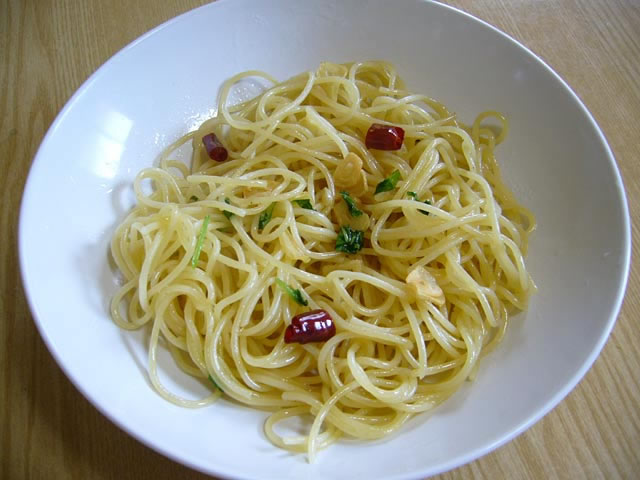
We frequently update our pages on Italian pasta with new classic and regional traditional recipes.